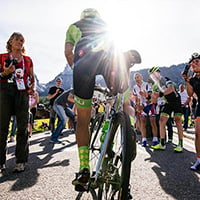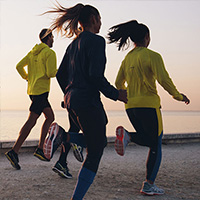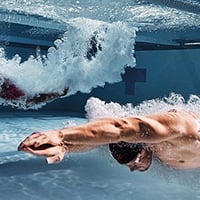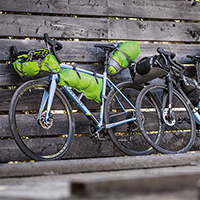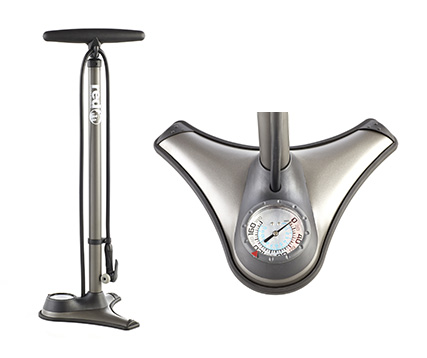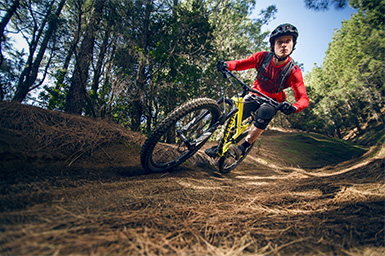Biketyres Guide
Buyers Guide: What to look for when choosing new tyres & inner tubes
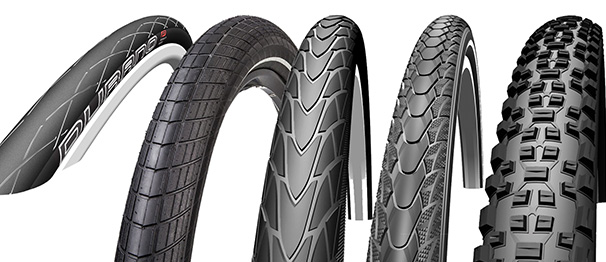
Tyres and inner tubes are a essential parts of any bicycle. These often overlooked components can really define how your bicycle performs, behaves and grips the surface you ride on. If your tyre is old and showing signs of wear and tear it is definitely time to buy a new one. You’ll avoid frequent punctures and rediscover the full potential of your bike again.
Tyres and inner tubes have different size notations, different widths and patterns, can be made of different compounds and are offered with different tyre systems. It might feel like a jungle, but once you know the basics, choosing the right tyre is actually pretty easy. In this guide we’ll go through how to find tyres and tubes that fit your bike and riding preference and the characteristics of different types of tyres for mountain bikes, road bikes and touring & city bikes.
Tyre Size Table
To find the correct tyre for your bike the most important thing to be aware of is the diameter of your wheel and the width of your tyre. If you feel unsure which size you need, you can always use the size of your existing tyres as orientation.
There are different size notations that can be found on the sidewall of your tyre. In order to make everything as easy as possible for you, we´ve put the most common size notations in the table below. You can look up your notation and easily convert to one of the other size notations use.
Tyre sizes - mountainbikes
| Bike type & wheelsize in shop | Inches | ETRTO | alternative notation | ||
| diameter | width in inches | width in mm | diameter | - | |
| MTB 20“ | 20 x | 1,9 - 2,25 | 47 to 57 - | 406 | - |
| MTB 24“ | 24 x | 1,75 - 2,4 | 47 to 63 | 507 | - |
| MTB 26“ | 26 x | 1,5 - 2,6 | 40 to 65 | 559 | - |
| MTB FAT | 26 x | 3,8 - 4,8 | 95 to 120 | 559 | - |
| MTB 27,5“ | 27,5 x | 1,9 - 2,5 | 48 to 64 | 584 | 650B |
| MTB 27,5+ /B+ | 27,5 x | 2,8 - 3,2 | 67 to 79 | 584 | B+ |
| MTB 29“ | 29 x | 1,9 - 2,4 | 47 to 63 | 622 | - |
Tyre sizes - trekking- & citybikes
| Bike type & wheelsize in shop | Inches | ETRTO | alternative notation | ||
| diameter | width in inches | width in mm | diameter | - | |
| Trekking /City 12“ | 12 x | 1,75 - 2,25 | 47 to 62 - | 203 | 12 ½ x 1,75 to 12 ½ x 2 ¼ |
| Trekking /City 14“ | 14 x | 1,5 - 1,75 | 38 to 47 - | 288 | 14 x 1 5/8 x 1 3/8 or 350 x 38A, 350 x 42A |
| Trekking /City 16“ | 16 x | 1,5 - 2,1 | 40 to 57 - | 305 | - |
| Trekking /City 18“ | 18 x | 1,25 - 2,0 | 32 to 50 - | 355 | - |
| Trekking /City 20“ | 20 x | 0,9 - 2,25 | 23 to 57 - | 406 | - |
| Trekking /City 24“ | 24 x | 1,5 - 2,4 | 40 to 62 - | 507 | - |
| Trekking /City 26“ | 26 x | 1,0 - 2,5 | 25 to 64 - | 559 | - |
| Trekking /City 27,5“ | 27,5 x | 1,125 - 2,5 | 28 to 57 - | 584 | 650 x 28B to 650 x 42B |
| Trekking /City 28“ | 28 x | 1 - 1,6 | 28 to 42 - | 622 | 700x28C to 700x42C |
| Trekking /City 29“ | 29 x | 1,9 - 2,4 | 47 to 63 - | 622 | - |
| Trekking /City 27“ (old standard not used anymore) | 27 x | 7/8 – 1/14 | 22 to 32 - | 630 | 27 x 7/8 to 27 x 1 ¼ |
Tyre sizes - road bikes, triathlon bikes and cyclocross bikes
| Bike type & wheelsize in shop | Inches | ETRTO | alternative notation | ||
| diameter | width in inches | width in mm | diameter | ||
| Roadbike and Triathlon 28 | 28 x | ¾ - 1 1/8 | 18 to 28 - | 622 | 700x18C to 700x28C |
| CX & Gravel 28 | 28 x | 1 – 1,6 | 28 to 42 - | 622 | 700x28C to 700x42C |
| Road Plus | 27,5 x | 1,5 - 2,6 | 35 to 47 - | 584 | 650B |
| Tria 26“ (old) | 26 x | 1 | 18 to 23 - | 551 | 650 x 18C to 650 x 23C |
Which tyre and inner tube fits my bike?
Choosing tyres – step by step
- Look for the size notation on the sidewalls of your old tyre (e.g. 32-622).
- Use our Tyre Size Table to convert the size notation into different tyre measurements if needed.
- Go to tyres on our website and use the filters to select the type of tyre you want as well as the wheel size you need (in inches).
- Tyres normally exist in different widths - make sure to choose a tyre width that will fit between your forks.
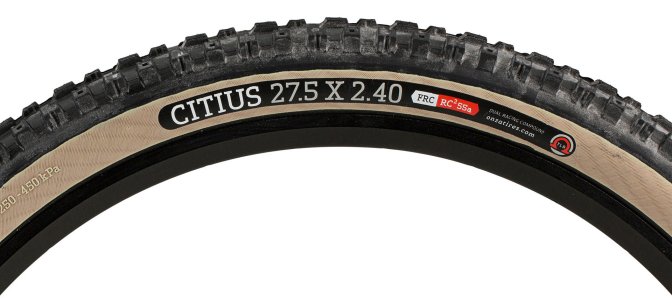
Choosing inner tubes – step by step
- Look for the size notation located on the side of your tyre.
- Use our Tyre Size Table to convert the size notation into different tyre measurements if needed.
- Go to inner tubes and use the filters to choose the correct wheel size (in inches).
- Choose an inner tube with the width that corresponds to your tyre.
- Choose an inner tube with a valve that is compatible with your wheel. You can see which type of valve you need by the size of the valve hole on your rim. There are three different types:
- SV: Presta valve Also known as Sklaverand valve, French valve) – 6,5 mm
- AV: Schrader valve (also known as automobile valve) – 8,5 mm
- DV: Dunlop valve (also known as Woods valve) – 8,5 mm
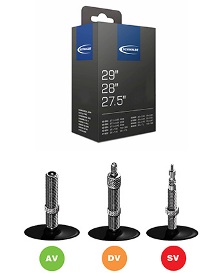
What tyre pressure should I run?
Having the correct tyre pressure will make your wheels roll better, contribute to a more comfortable ride and reduce the risk of punctures.
- Running a high air pressure makes the wheel roll faster, but it doesn’t absorb vibrations as well.
- Running a low air pressure makes the wheel roll a little slower, but increases comfort and control.
On most tyres you can find a tyre pressure range on the side of the tyre. Please keep the tyre pressure in that recommended range to avoid damaging your tyres or tubes by running your pressure too low or high.
We also recommend checking the tyre pressure every other week to make sure your tyre hasn’t lost too much pressure. You can easily pump your tyre to the desired pressure by using a pump that has a manometer. Tyre pressure is measured in two different ways: BAR or PSI.
Most floor pumps offer both scales simultaneously.
Tyre width, tread pattern and compound
Tyre width
- Narrow tyres are generally run at a higher air pressure, therefore tend to roll faster and are suitable for hard and smooth surfaces.
- Wider tyres are generally run with a lower air pressure which gives more control and comfort thanks to better traction and grip. They are suitable for more uneven surfaces.
- High air volume tyres (like “plus size” and fat bike tyres) have a larger contact path which improves traction and are especially well suited for loose surfaces such as snowy and sandy terrains.
Tyre tread pattern
Depending on the pattern on the tyre it will be good for different types of riding and different types of weather conditions
- Mountain bikes and cyclcocross/gravel bike tyres have many different patterns to choose from, whilst road bike tyres don’t have any tread pattern.
Tyre compound
The compound decides the softness of the rubber, which affects the rolling speed and durability of a tyre. Tyres with a durometer of 70 are considered “hard” and tend to be cheap, fast-rolling and long-lasting. Most trekking and city tyres will use this compound to last long and roll well.
Tyres with a durometer of 50 are considered “soft” and are sticky, grippy and less durable. This compound is often used for downhill mountain bikes where every bit of traction is needed and frequent tyre changes are more common. Also it is popular for wet condition tyres. You´ll find this compound use in all types of biking because of that.
Some more expensive performance tyres use multiple rubber compounds to optimise rolling speed, durability and grip.
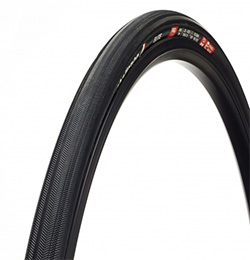
A tyre with smaller knobs that are closely fitted together will roll faster, but offer less grip on loose or wet surface. Perfect for dry, fast-rolling conditions.
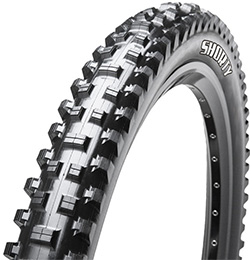
A tyre with bigger, often edged knobs and more space between the knobs rolls slower but offers more grip on loose or wet surfaces. Perfect for rougher and muddier conditions.
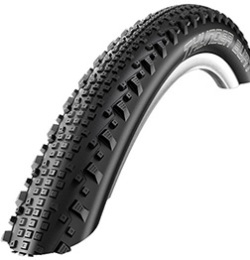
A tyre with a narrow pattern in the middle and bigger, more edged knobs on the sides is often called semi slick and combines the fast rolling for hardpack surfaces with a bit of extra grip when cornering on loose surfaces.
What tyre system do i run?
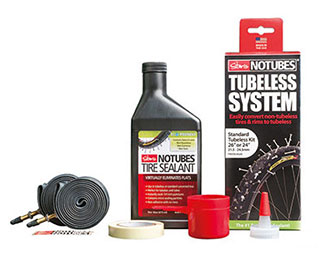
Tubeless tyres
Tubeless and Tubeless Ready tyres can be used without an inner tube. Those tyres use the same beaded technology as normal clinchers, but manufacturer additionally made them easy to seal and therefore they hold can hold the air without an inner tube. This system increases grip, comfort and protects better against punctures, especially pinch flats. Both, mountain bikers, cyclocross and road riders use them. In order to convert to tubeless you need a tubeless ready tyre, special rim tape, tubeless valves and tubeless sealant.
+ Minimise punctures
+ More grip / less air pressure needed
+ Light setup
+ Faster rolling
- Harder to change / setup
- Need frequent air pressure checking
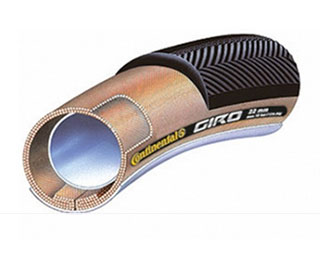
Tubular tyres
Tubular tyres are tyres that have the inner tube sewn into the tyre. This tyre does not hook onto the rim but is glued or taped to a rim with a special profile. They are mainly used within road racing and cyclocross racing because of their fast and smooth rolling characteristics and low weight.
+ Roll very fast and smooth
+ Allow very low and very high air pressures
+ Minimise punctures
- Expensive (also requires special rims)
- Harder to change
- Can´t be repaired whilst out riding
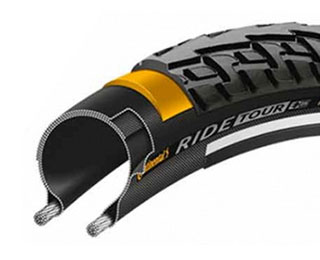
Clincher tyres & inner tubes
Clinchers are traditional beaded tyres that are usually combined with an inner tube. The tyres have two strong hoops of steel or kevlar that “hook” onto the rim of the wheel, to keep it in place. Steel bead is also known as “wire bead” and is the cheaper option. Kevlar beads are also known as “folding tyres” and are lighter and fold easily.
+ Relatively cheap
+ Wide selection of tyres and tubes
+ Easy to change and repair
- Puncture more easily
- Slightly slower rolling
MTB, E-Bike, Road & Trekking Tyres
Tyres for mountain bikes
There are three wheel sizes for MTB: 26’’, 27,5’’(also known as 650B) and 29’’. There are three different types of tyres for mountain bikes:
- Standard tyres are between 1,9 and 2.5’’ wide. Cross country and marathon riders normally run narrower tyres between 1,9 and 2,1’’ to save weight and maximise rolling efficiency. All-mountain and Enduro riders tend to ride wider tyres between 2.1 and 2.5 to increase grip and control.
- “Plus size” tyres are between 2,6 and 3,25’’ wide. They are also known as B+ or simply “+” and are used to get even more control and comfort on rough mountain bike trails. Plus sized bikes come with extra wide rims and an extra wide fork for extra tyre clearance.
- Fatbike tyres are between 3,8 and 4,8’’ wide. These voluminous tyres are made especially for fat bikes which makes it possible to ride on snow and sand. However due to the high air volume and low tyre pressure makes them slower and heavier on trails in normal conditions.
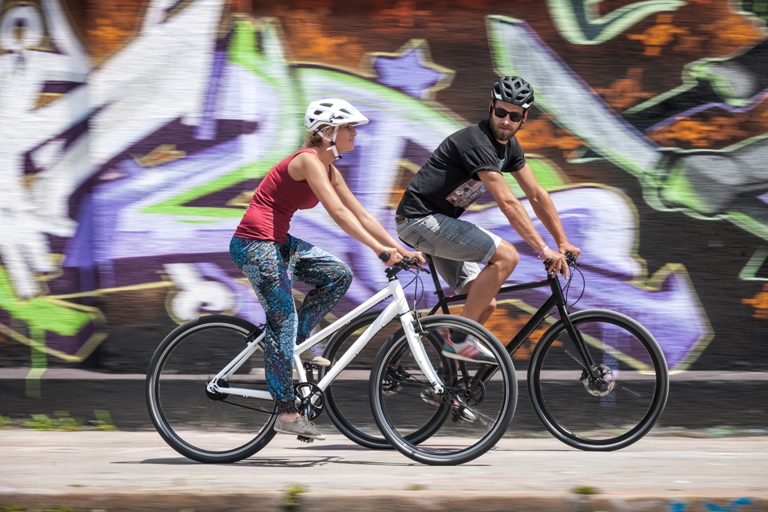
Tyres for trekking & city bikes
- Wheel sizes for trekking & city bikes tyres range from 12’’ kids bikes up to 28’’ adult bikes.
- The width of tyres for trekking & city bikes range from around 1,0 to 2,1 inches (23 – 57 mm) depending on how much space you have between your fork and what type of tyre you want to run.
- The tread pattern tends to be minimal to make them as fast rolling as possible.
- A lot of the tyres are durable and have puncture resistance, which is important when riding in an urban environment.
Tyres for E-bikes
- The wheel sizes for E-bikes depend on what type of E-bike you have: MTB, Road bike or City/trekking bike.
- They are wider and more durable than a standard tyre to compensate for the higher average speed and slight increase of weight.
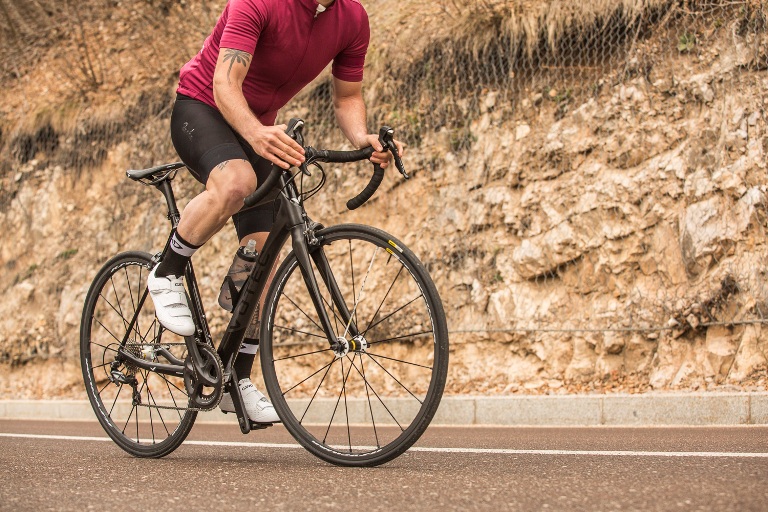
Tyres for road bikes
There is one main wheel size for road bikes: 28’’. There are two main different types of road tyres:
Road tyres
- Road tyres are between 23 and 28 mm wide. They have little to no pattern, run a high air pressure and are fast rolling.
- Many road racers run 23-25 mm wide tyres as they can be inflated to a higher pressure to get maximum speed out of the tyres.
- Some racers even run 28 mm tyres. They are normally used where extra comfort is need, for example when riding on more uneven surfaces, cobblestones, winter training or daily commuting.
Cyclocross- and gravel tyres
- Cyclocross and gravel bike tyres are between 28 and 35 mm wide.
- They run a lower air pressure and have a tread pattern that makes it grip better in mud and on slippy surfaces, as well as roll pretty fast.
- They are great for off-road riding on gravel and forest paths, as well as urban riding in wet conditions.
The perfect company for your set of tyres and inner tubes
Depending on the tyre system you choose, there are a few tools and equipment that will make your life easier when changing the tyres at home or on the road
- Floor Pumps for fast and easy air pressure adjustments at home
- Mini pumps for quick repairs on the road
- Tyre levers - great helper to (dis)mount your tyre
- Puncture reparation kit when things don’t go as planned






























